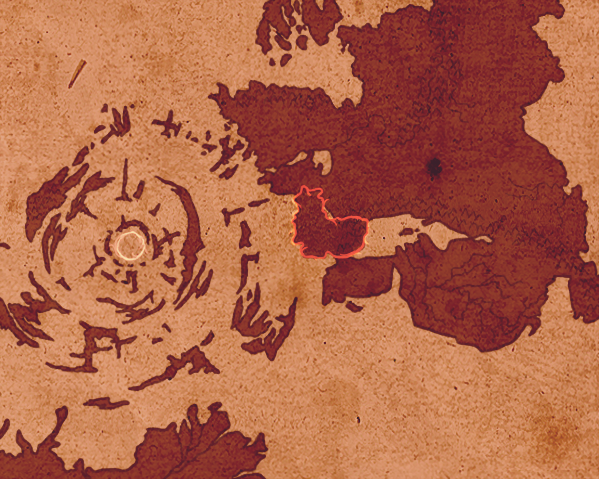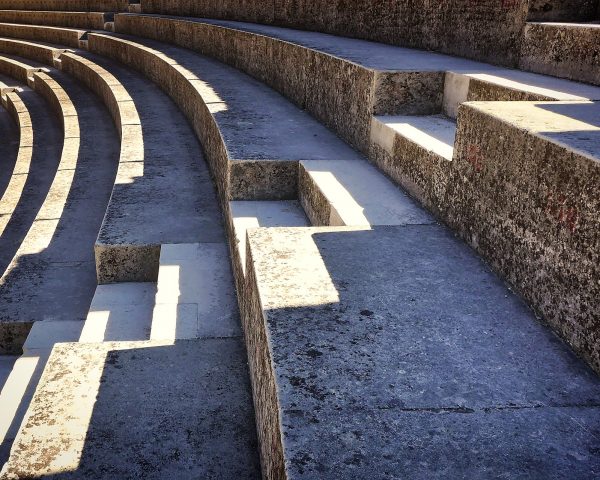“Imagine: a story being told about peasants and royals and why it is important that they remain in place and all the while the audience knows full-well that the king and queen are really a miner and his wife. This is why I so enjoy the Chiropes. Their obedient disobedience; their smug love of implicit contradiction.”
-The Heretic's Guide to Homecoming, Book One: Theory
Lush Hills and Stormy Seas
Sandwiched between two fierce and majestic seas, Chiropole is a land where stories flow like water. In its gentlest seasons, the sun shines down upon the balmy, humid environment; in its most tumultuous, monsoons are a regular occurrence, flooding the lands with enthusiasm. All this moisture lends itself to a landscape of rich greenery covering both the plains of the west and the rolling hills of the east.
In human-inhabited areas, it is not uncommon to see stacks of terraced hillsides, used for the bountiful rice harvest of Chiropolene farmers. Rice is a major food export of Chiropole, and is often traded with the Kingdom of ka-Khasta, the major power in North Berena. Lining the northeast of the region is the stunning mountain range known as Chalisto’s Belt, which marks the furthest east you can go in Chiropole before bumping into the Iphigene Sea. The west coast is where the land meets the tamest edges of the Shattered Sea, welcoming traders and travelers to share their goods and stories.
Though it is less common in Chiropole than it is in ka-Khasta, you can still find the remains of the Trans-Bereni Highway scattered throughout the region.
A Nation and its Identity Crises
Compared to the dense forests of ka-Khasta to the north, Chiropole’s landscape is relatively forgiving, with few predators to seriously disturb human travelers. This has given humans the luxury of settling all across the region, in everything from remote farm towns to major cities. There are also several coastal trade ports, notably Ithos on the Shattered Sea and Scybia on the Iphigene. Much of Chiropole is crossed by aqueducts, which allow for the presence of bathhouses in many of the larger cities.
Aeonna, home to a legendary stage called the Green Gate, is considered to be Chiropole’s capital–at the very least, it is the largest inland city. This is made possible by the city’s connection with the Kingdom of ka-Khasta, their most valuable and influential trade partner. Feelings about this relationship are somewhat complicated; while there hasn’t been any aggressive conflict between the regions in centuries, some Chiropes are wary of the level of cultural influence ka-Khasta has. Fans of the kingdom claim that imitating and collaborating with ka-Khasta can only lead to the success of both countries, but staunch nationalists fear that Chiropole might be losing parts of its traditional cultural identity.
In truth, the regions have been in collaboration for so long that it is hard to tell which practices started where. One true piece of Chiropolene culture would be aephelys, or ‘siege’, a competitive board game that can be found in parks all across the country. Should you wish to learn how to play, ask any Chirope nearby–they’d be glad to show off this part of their heritage!
Clever Gods and Wicked Demons
Chiropole has a set pantheon of about thirty different gods, individually worshipped in varying degrees from city to city. Generic temples can be found all over, with the occasional shrine to a specific god erected by a particularly devout follower. Most cities have a god or two that they worship to a larger extent, depending on what that god rules over and how it might impact their daily lives.
Holidays are celebrated nation-wide, though many towns have additional local holidays. Aside from these specific days, an individual’s particular religious practices tend to be more of a private matter. Should you feel a deep connection to your gods, you can bring offerings to temples and speak to the priestesses who interpret their will. These women can be identified by their elaborate hairstyles, and serve as local oracles who guide people in understanding what their roles in the world’s performance are. These temples also have monks, who perform the lesser duties of keeping the temples cleaned, organized, and guarded.
Many coastal towns also engage in water worship, with varying interpretations of sea goddesses. One of the oldest of these goddesses is known as the Maelstrom, who has a varying number of daughters from story to story, and a notoriously stormy disposition. Though the ancient stories of her are wide in number, all can agree it is best to stay on her good side.
Indeed, Chiropolene spiritual figures have a tendency to be somewhat fickle and melodramatic. Along with the gods is a strong belief in demons, who are quick to trick the foolish and cause all sorts of mischief. Even the most irreverent Chirope will warn you of the ill-tempered spirits lurking in the woods.
- Geography
-
Lush Hills and Stormy Seas
Sandwiched between two fierce and majestic seas, Chiropole is a land where stories flow like water. In its gentlest seasons, the sun shines down upon the balmy, humid environment; in its most tumultuous, monsoons are a regular occurrence, flooding the lands with enthusiasm. All this moisture lends itself to a landscape of rich greenery covering both the plains of the west and the rolling hills of the east.
In human-inhabited areas, it is not uncommon to see stacks of terraced hillsides, used for the bountiful rice harvest of Chiropolene farmers. Rice is a major food export of Chiropole, and is often traded with the Kingdom of ka-Khasta, the major power in North Berena. Lining the northeast of the region is the stunning mountain range known as Chalisto’s Belt, which marks the furthest east you can go in Chiropole before bumping into the Iphigene Sea. The west coast is where the land meets the tamest edges of the Shattered Sea, welcoming traders and travelers to share their goods and stories.
Though it is less common in Chiropole than it is in ka-Khasta, you can still find the remains of the Trans-Bereni Highway scattered throughout the region.
- Human Settlements
-
A Nation and its Identity Crises
Compared to the dense forests of ka-Khasta to the north, Chiropole’s landscape is relatively forgiving, with few predators to seriously disturb human travelers. This has given humans the luxury of settling all across the region, in everything from remote farm towns to major cities. There are also several coastal trade ports, notably Ithos on the Shattered Sea and Scybia on the Iphigene. Much of Chiropole is crossed by aqueducts, which allow for the presence of bathhouses in many of the larger cities.
Aeonna, home to a legendary stage called the Green Gate, is considered to be Chiropole’s capital–at the very least, it is the largest inland city. This is made possible by the city’s connection with the Kingdom of ka-Khasta, their most valuable and influential trade partner. Feelings about this relationship are somewhat complicated; while there hasn’t been any aggressive conflict between the regions in centuries, some Chiropes are wary of the level of cultural influence ka-Khasta has. Fans of the kingdom claim that imitating and collaborating with ka-Khasta can only lead to the success of both countries, but staunch nationalists fear that Chiropole might be losing parts of its traditional cultural identity.
In truth, the regions have been in collaboration for so long that it is hard to tell which practices started where. One true piece of Chiropolene culture would be aephelys, or ‘siege’, a competitive board game that can be found in parks all across the country. Should you wish to learn how to play, ask any Chirope nearby–they’d be glad to show off this part of their heritage!
- Religion
-
Clever Gods and Wicked Demons
Chiropole has a set pantheon of about thirty different gods, individually worshipped in varying degrees from city to city. Generic temples can be found all over, with the occasional shrine to a specific god erected by a particularly devout follower. Most cities have a god or two that they worship to a larger extent, depending on what that god rules over and how it might impact their daily lives.
Holidays are celebrated nation-wide, though many towns have additional local holidays. Aside from these specific days, an individual’s particular religious practices tend to be more of a private matter. Should you feel a deep connection to your gods, you can bring offerings to temples and speak to the priestesses who interpret their will. These women can be identified by their elaborate hairstyles, and serve as local oracles who guide people in understanding what their roles in the world’s performance are. These temples also have monks, who perform the lesser duties of keeping the temples cleaned, organized, and guarded.
Many coastal towns also engage in water worship, with varying interpretations of sea goddesses. One of the oldest of these goddesses is known as the Maelstrom, who has a varying number of daughters from story to story, and a notoriously stormy disposition. Though the ancient stories of her are wide in number, all can agree it is best to stay on her good side.
Indeed, Chiropolene spiritual figures have a tendency to be somewhat fickle and melodramatic. Along with the gods is a strong belief in demons, who are quick to trick the foolish and cause all sorts of mischief. Even the most irreverent Chirope will warn you of the ill-tempered spirits lurking in the woods.
Most Holy Actors
To be Chiropolene is to know and love the theatre. Interaction with the many Chiropolene stories is essential to cultural literacy, whether you are a leading role in one of the performances, a no-nonsense stagehand, or an ever-vital audience member. The tales within the Chiropolene canon are passed down primarily through oral tradition, and are performed in towns by the local theatrical families. If you are born into one of these families, it is expected that you will become a performer yourself–and a great one, at that. Smaller towns who do not have these families rely on travelling performance troupes known as Tellers.
These stories are so ritualized and culturally-resonant that there’s actually a specific dialect of Chiropolene used for performance and storytelling. Stories often begin with the word “Listen” in this aforementioned dialect, signalling the transition from the world of the audience to the world of the story. When the story is over, the teller will switch back to standard Chiropolene, and the listeners will promptly launch into hearty debate. The Chiropolene believe art is meant to be interrogated, and that discussions about both the quality of the telling and the meaning of the piece are what complete the art of storytelling.
While a story can be told anywhere, the most important performances happen under the archways. These stone structures are scattered all across the country, and Chiropes will gather to watch plays be performed beneath them on holidays. The archways are not simply stages–they are also gates that offer the gods a direct line of sight to bear witness to the performers. The Chiropolene view the world as one endless play being put on for the amusement of their gods; if they live good lives, they believe, they will earn a place in the eternal audience. Art is therefore not just a source of entertainment–it is an act of worship.
A Land of Rigid Customs
Chiropole has a strict caste system, where people are born into specific roles they are expected to fulfill for the rest of their life. There is not much opportunity for moving out of one’s social class. Acting out against one’s caste can not only have legal repercussions, but is also thought to be a mark against your earning a place in the eternal audience. If you are set up to have a challenging labourer’s life, you must not complain or envy the gentle lives of the wealthy–instead, you must be grateful and do an excellent job of it. One way out of this would be to marry up and out of your caste, but that is not always regarded favorably.
A loophole in this system can actually be found within the context of the Tellers; while actors are only supposed to play characters of their social class, people have no way of knowing which class a Teller began in. This allows them to suspend their disbelief and give the Tellers the opportunity to transform and step into different roles. In smaller towns, the occasional open casting call will be allowed for a play–a small act of rebellion against an otherwise rigid social structure.
Another strict piece of Chiropolene culture would be distinction of gender roles. Man and Woman are the only recognized genders, and there is no opportunity for divergence from monogamy or heterosexuality. For the most part, public places are segregated by gender, and certain roles are forbidden to each gender. For example, women are not allowed in the politically-charged coffeehouses, and men would never be considered interpreters of the gods’ will. Women are also expected to observe certain modesty practices, such as keeping their shoulders covered with a shawl no matter the heat. Diverging from gendered expectations is just as, if not more, dangerous than challenging the caste systems.
Despite all of the rules in place for the Chiropolene, the people tend to be relatively easy going, with a biting and sarcastic sense of humor. Cursing in Chiropolene can be thought of as one of the language’s greatest pleasures, spoken from the mouths of petulant teenagers and cantankerous grandmothers alike.
Guided by Grim and Whimsical Tales
While the Chiropolene canon of storytelling is incredibly vast, there are certain key elements that come up time and time again in the classics. One of these would be the setting of Thesopole, a legendary city that was said to have sat on the edge of the Iphigene Sea before a powerful storm swallowed it up, and pushed the earth up into Chalisto’s Belt. Though there is no evidence that it ever existed, archaeologists tend to go digging every few decades, hoping to find proof of where it sat.
Many of these stories serve as reminders of how to behave, warning listeners of the dangers of acting out against the will of the gods or entering dangerous relationships. Some common stories would be The Poison Boy, The Hungry Mask, and The Song of the Monsoon–though you may hear different versions depending on what region the storyteller is from, or what theme they are looking to explore most closely.
Also notable to Chiropolene storytelling is the Galene Period, an artistic renaissance wherein many of the old pagan stories were revived into the canon. Many of the main characters were animals in these early stories, and have taken on human forms in the revival. Take for example the story of Livellou:
In the oldest version of the story, a dragonfly named Livellou lauds her beauty over a plain black spider, mocking it for its ugliness. The spider, being the symbol of both intelligence and madness, pleads with the gods to even the score. The gods agree that Livellou’s behavior is unacceptable, and tell the spider to weave a web to catch her. As the dragonfly is caught in the web, the gods whisper to her that she actually is a spider, but with the deformation of horrible, hideous wings. Distraught, Livellou chews off her own wings and tail, and dies stuck to the web.In the modern story, Livellou is a beautiful girl who cruelly mocks lepers and amputees, who then plead with the gods for justice. The gods poison the girl’s mind and, depending on the story, she either sees everyone as disfigured and therefore finds her beauty ugly, or she sees everyone as beautiful and her own body as disfigured. Either way, eventually the dissonance becomes too much and she mutilates herself, which results in her death.
- Theatre Culture
-
Most Holy Actors
To be Chiropolene is to know and love the theatre. Interaction with the many Chiropolene stories is essential to cultural literacy, whether you are a leading role in one of the performances, a no-nonsense stagehand, or an ever-vital audience member. The tales within the Chiropolene canon are passed down primarily through oral tradition, and are performed in towns by the local theatrical families. If you are born into one of these families, it is expected that you will become a performer yourself–and a great one, at that. Smaller towns who do not have these families rely on travelling performance troupes known as Tellers.
These stories are so ritualized and culturally-resonant that there’s actually a specific dialect of Chiropolene used for performance and storytelling. Stories often begin with the word “Listen” in this aforementioned dialect, signalling the transition from the world of the audience to the world of the story. When the story is over, the teller will switch back to standard Chiropolene, and the listeners will promptly launch into hearty debate. The Chiropolene believe art is meant to be interrogated, and that discussions about both the quality of the telling and the meaning of the piece are what complete the art of storytelling.
While a story can be told anywhere, the most important performances happen under the archways. These stone structures are scattered all across the country, and Chiropes will gather to watch plays be performed beneath them on holidays. The archways are not simply stages–they are also gates that offer the gods a direct line of sight to bear witness to the performers. The Chiropolene view the world as one endless play being put on for the amusement of their gods; if they live good lives, they believe, they will earn a place in the eternal audience. Art is therefore not just a source of entertainment–it is an act of worship.
- Societal Expectations
-
A Land of Rigid Customs
Chiropole has a strict caste system, where people are born into specific roles they are expected to fulfill for the rest of their life. There is not much opportunity for moving out of one’s social class. Acting out against one’s caste can not only have legal repercussions, but is also thought to be a mark against your earning a place in the eternal audience. If you are set up to have a challenging labourer’s life, you must not complain or envy the gentle lives of the wealthy–instead, you must be grateful and do an excellent job of it. One way out of this would be to marry up and out of your caste, but that is not always regarded favorably.
A loophole in this system can actually be found within the context of the Tellers; while actors are only supposed to play characters of their social class, people have no way of knowing which class a Teller began in. This allows them to suspend their disbelief and give the Tellers the opportunity to transform and step into different roles. In smaller towns, the occasional open casting call will be allowed for a play–a small act of rebellion against an otherwise rigid social structure.
Another strict piece of Chiropolene culture would be distinction of gender roles. Man and Woman are the only recognized genders, and there is no opportunity for divergence from monogamy or heterosexuality. For the most part, public places are segregated by gender, and certain roles are forbidden to each gender. For example, women are not allowed in the politically-charged coffeehouses, and men would never be considered interpreters of the gods’ will. Women are also expected to observe certain modesty practices, such as keeping their shoulders covered with a shawl no matter the heat. Diverging from gendered expectations is just as, if not more, dangerous than challenging the caste systems.
Despite all of the rules in place for the Chiropolene, the people tend to be relatively easy going, with a biting and sarcastic sense of humor. Cursing in Chiropolene can be thought of as one of the language’s greatest pleasures, spoken from the mouths of petulant teenagers and cantankerous grandmothers alike.
- The Stories
-
Guided by Grim and Whimsical Tales
While the Chiropolene canon of storytelling is incredibly vast, there are certain key elements that come up time and time again in the classics. One of these would be the setting of Thesopole, a legendary city that was said to have sat on the edge of the Iphigene Sea before a powerful storm swallowed it up, and pushed the earth up into Chalisto’s Belt. Though there is no evidence that it ever existed, archaeologists tend to go digging every few decades, hoping to find proof of where it sat.
Many of these stories serve as reminders of how to behave, warning listeners of the dangers of acting out against the will of the gods or entering dangerous relationships. Some common stories would be The Poison Boy, The Hungry Mask, and The Song of the Monsoon–though you may hear different versions depending on what region the storyteller is from, or what theme they are looking to explore most closely.
Also notable to Chiropolene storytelling is the Galene Period, an artistic renaissance wherein many of the old pagan stories were revived into the canon. Many of the main characters were animals in these early stories, and have taken on human forms in the revival. Take for example the story of Livellou:
In the oldest version of the story, a dragonfly named Livellou lauds her beauty over a plain black spider, mocking it for its ugliness. The spider, being the symbol of both intelligence and madness, pleads with the gods to even the score. The gods agree that Livellou’s behavior is unacceptable, and tell the spider to weave a web to catch her. As the dragonfly is caught in the web, the gods whisper to her that she actually is a spider, but with the deformation of horrible, hideous wings. Distraught, Livellou chews off her own wings and tail, and dies stuck to the web.In the modern story, Livellou is a beautiful girl who cruelly mocks lepers and amputees, who then plead with the gods for justice. The gods poison the girl’s mind and, depending on the story, she either sees everyone as disfigured and therefore finds her beauty ugly, or she sees everyone as beautiful and her own body as disfigured. Either way, eventually the dissonance becomes too much and she mutilates herself, which results in her death.






